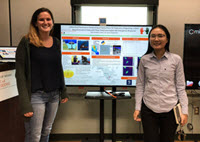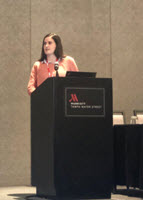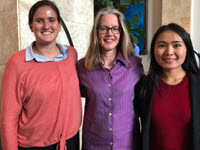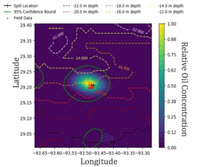
Oil spilled in the ocean can sink to the seafloor due to its high density or by attaching to floating particulate matter, as happened during the Marine Oil Snow Sedimentation and Flocculent Accumulation (MOSSFA) event following Deepwater Horizon. Oil that reaches the seafloor can smother benthic organisms or the organisms can ingest it, causing long-term negative effects, as happened to some deep-water coral and foraminifera.
Advanced tools are needed to predict oil transport to shorelines or if it will sink to the seafloor and affect sensitive ecosystems. The Subsurface Oil Simulator (SOSim) model, originally developed by the NOAA Response and Restoration’s Emergency Response Division during Deepwater Horizon, uses statistics to infer the velocity and dispersion of oil spilled in the water column and predict oil’s transport. The model was initially developed to track only sunken oil (oil that has reached the seafloor) on flat bay bottoms following an instantaneous spill, conditions that represent only a portion of the Gulf of Mexico environment.

Mary Jacketti is using field data and bathymetric data to develop computational codes that will expand the capabilities of the SOSim model so that it can track sunken oil from instantaneous and continuous spills in bay, river, coastal, and continental shelf environments. Simulations that incorporate these areas can help responders locate sunken oil during emergency spill response.
Mary is a Ph.D. student with the University of Miami’s Department of Civil, Architectural and Environmental Engineering and a GoMRI Scholar with the project Inferential/Parametric Forecasting of Subsurface Oil Trajectory Integrating Limited Reconnaissance Data with Flow Field Information for Emergency Response.
Her Path
Mary developed a love for science through her middle school’s annual science fair. She enjoyed identifying a scientific problem, developing methods to solve the problem, and analyzing results. During high school, she often participated in outdoor adventures and became passionate about the environment. While preparing for college, she realized that environmental engineering would allow her to use science and mathematics to develop new ways to lessen human impacts on the environments.

As an environmental engineering undergraduate student at the University of Miami, Mary served as the treasurer for the Society of Women Engineers. She participated in the group’s annual Introduce a Girl to Engineering Day, which taught elementary school girls about diverse STEM careers. She also participated in a research internship documenting whale and dolphin behavior for the Cape May Whale Watch and Research Center. During her internship, she conducted her own research project assessing water quality of waterbodies in Southern New Jersey. Mary later volunteered for an EPA-funded project using nanoparticles to filter antibiotic resistant contaminants out of drinking water.
“My undergraduate experiences showed me that I am passionate about conducting research that will better the environment and public health. I also found a great passion advocating for women in STEM fields to help narrow the gender gap in classrooms and the workplace,” said Mary. “I hope to be able to conduct research that will stand the test of time, while also motivating and illuminating the path for young women to conduct research in STEM.”
After completing her bachelor’s degree, University of Mami professor Dr. James Englehardt asked Mary if would join his GoMRI-funded research team developing a model that helps minimize how oil spills impact the environment. Mary knew she could directly apply skills she learned as an undergraduate student to improve the way scientists approach emergency oil spill response. She joined Dr. Englehardt’s lab as a Ph.D. student and is helping develop code that will allow the SOSim model to more accurately track sunken oil.
Her Work

Mary explained that her research adds a new component to the team’s efforts to expand the SOSim model capability to track submerged oil (oil suspended in the water column). While the submerged oil model uses output from existing trajectory models (such as the SINTEF Oil Spill Contingency and Response, or OSCAR model) to identify which ocean layers will likely contain oil, the sunken oil model she’s working on uses bathymetric data to simulate a selected area’s seafloor depth. If submerged oil in the area’s water column eventually sinks, the sunken oil model can predict where it will settle.
Mary dedicated her initial efforts to learning about the Python coding language and Bayesian statistical theory, which quantitatively updates predictions as new information becomes available. She began developing simple modeling code to simulate pollutant location and concentration and then expanded the code to include sunken oil. Together, she and Dr. Englehardt developed a strategy to incorporate bathymetry data into the model with existing field data to inform the Bayesian statistical methods that infer unknown model parameters, including oil diffusion and velocity and how many oil patches are on the seafloor.
“Bathymetry plays a significant role in how the sunken oil will be transported, since oil will generally follow contours of constant depth, travelling to and residing in the deeper areas,” Mary said. “Including bathymetry into the SOSim model will help improve spatial and temporal maps of relative sunken oil concentrations for use during emergency response operations.”
Mary validates the new code using available synthetic data (data generated to help simulate certain conditions not seen in the field data) and field data from past spills. She generates SOSim hindcasts to determine if the model can correctly predict the location of the sunken oil and conducts future simulations to see if the model can provide reasonable results. Preliminary results showed that the inclusion of bathymetric data increased the model’s accuracy when predicting sunken oil’s location and transport. Despite relatively sparse sampling of sunken oil concentrations, the SOSim model can make viable predictions using available prior oil spill data to infer oil’s location. Mary acknowledged that having several days of sampled field data improves the model’s prediction accuracy.
“We hope that this model will aid responders in locating and tracking sunken oil [in future spills], resulting in quicker recovery of the oil from the bottom and minimizing the negative impacts the oil may have,” she said. “If SOSim is used during emergency response in the future, field data collected by oil spill responders can be used to further inform the model.”
Her Learning
Dr. Englehardt’s mentorship taught Mary to approach problems in increasingly critical ways and appreciate the power of asking questions. While he encouraged Mary to conduct her research independently and create her own solutions, he was always available to guide and assist. She learned that regardless of the research being conducted, scientists attempt to solve questions and discover new solutions to address problems.
When the team visited SINTEF Ocean in Trondheim, Norway, Mary was excited about the opportunity to work alongside researchers from international institutions. Presenting her research to these scientists improved her presentation skills and hearing their reports improved her knowledge about oil spill modeling. She utilized these skills when presenting her research at the 2020 Gulf of Mexico Oil Spill and Ecosystem Science (GoMOSES) Conference. “At the GoMOSES conference, I was able to attend a graduate student luncheon, where I discussed my research and future career endeavors with other scholars and experts in the field,” she said. “I will forever be grateful for the opportunity GoMRI gave me to conduct research on a topic I am passionate about, while showcasing my research to others in the field.”
As GoMRI comes to a close, Mary will continue her graduate student career through new projects. She plans to find an industry position in risk analysis and environmental modeling that will help her leave a lasting, positive impact on the environment, something she feels passionately about.
Praise for Mary
Dr. Englehardt first noticed Mary when she was a student in his senior-level solid and hazardous waste engineering course. He recalled that she consistently performed at the top of her class and had a positive “team spirit” attitude towards group projects. “When it came time [for Mary] to devise a course project with her classmate, the result was inspirational,” he said. “Mary and her partner conceived and designed a vessel to clean up the Great Pacific Garbage Patch that was at least partially self-propelled, effective, and sustainable. I was impressed with the design, which they developed almost entirely independently.”
Mary’s steady nature and self-imposed high standards prompted Dr. Englehardt to offer her a graduate research position with his team while she was still an undergraduate student. She continued to perform as a top student in Englehardt’s graduate courses while simultaneously battling the steep learning curve associated with her GoMRI research and completing an independent study developing a new microbial risk assessment method.
“Mary has mastered the advanced Bayesian probability and statistical inference skills required for our work and become a facile computational scientist. I depend on her qualifications and consistent commitment to excellence every day as we complete the development of our novel Bayesian model,” he said. “All of us on the team consider Mary a good friend, especially her close co-worker Chao Ji, with whom she runs marathon-style events in her spare time. Along with the rest of our team, I look forward to keeping in touch with Mary and following her career wherever it may lead.”
The GoMRI community embraces bright and dedicated students like Mary Jacketti and their important contributions. The GoMRI Scholars Program recognizes graduate students whose work focuses on GoMRI-funded projects and builds community for the next generation of ocean science professionals.
By Stephanie Ellis and Nilde Maggie Dannreuther. Contact sellis@ngi.msstate.edu for questions or comments.
************
The Gulf of Mexico Research Initiative (GoMRI) is a 10-year independent research program established to study the effect, and the potential associated impact, of hydrocarbon releases on the environment and public health, as well as to develop improved spill mitigation, oil detection, characterization and remediation technologies. An independent and academic 20-member Research Board makes the funding and research direction decisions to ensure the intellectual quality, effectiveness and academic independence of the GoMRI research. All research data, findings and publications will be made publicly available. The program was established through a $500 million financial commitment from BP. For more information, visit http://gulfresearchinitiative.org/.
© Copyright 2010-2020 Gulf of Mexico Research Initiative (GoMRI) – All Rights Reserved. Redistribution is encouraged with acknowledgement to the Gulf of Mexico Research Initiative (GoMRI). Please credit images and/or videos as done in each article. Questions? Contact web-content editor Nilde “Maggie” Dannreuther, Northern Gulf Institute, Mississippi State University (maggied@ngi.msstate.edu).
